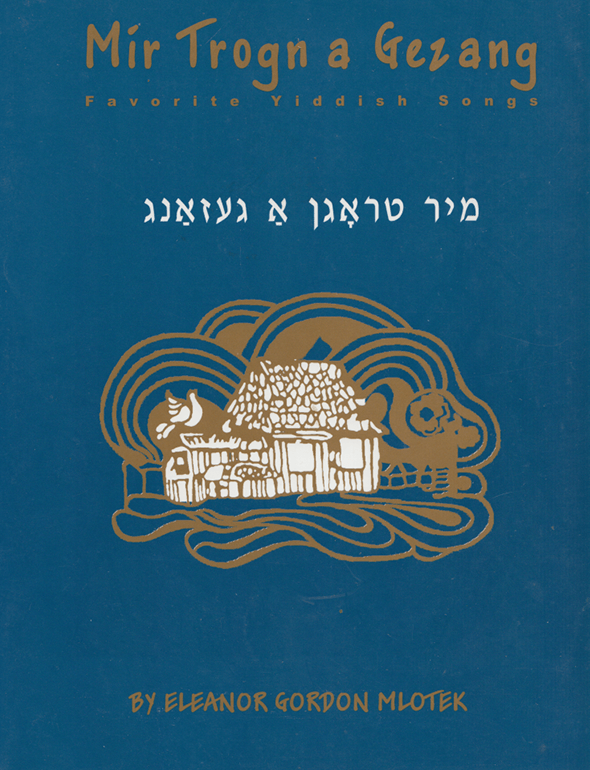This song was written by M. Knapheise (b. 1910), poet who survived the war in Russia and migrated to Argentina, where he was editor of a Yiddish literary magazine. The music is by S. Beresovsky (1908-1975). The song was written after the Holocaust and was sung in the Displaced Persons camps in Europe.

Open the doors and open the gates,
enough already, enough suffering
with flags waving, free people are marching.
From the bunkers, from the holes
we will all climb out higher
because we are saying, “The Jewish People lives!”
Life will rise up again
and with it a redress
we will give for all that is gone;
Lay one brick after another,
wings are spread over us
by fate – “The Jewish People lives!”
The sun is shining again,
happiness shines through tears.
To life, sisters and brothers,
we turn ourselves again.
How much fear there has been,
that we have withstood,
ghettos, camps, full with cries of torture!
we Jewish people remain,
and our song will again
resound afar, “The Jewish People lives!”
The Yiddish language, our mother tongue,
has not been muted or extinguished,
it has shed itself from torment and pain.
From the ashes, from the dust,
we have lifted lifted it up
like a flag, “The Jewish People live!”
Efnt tir un efnt toyer,
Shoyn genug, genug der troyer,
Mit fonen-flater shpant atsind di fray.
Fun di bunkers, fun di lekher
Shtaygn veln mir alts hekher,
Vayl mir zogn: am yisroel khay!
Vider oyfgeyn vet dos lebn
Un dermit a tikn gebn
Veln mir dos alts vos iz farbay;
Leygt a tsigl tsu a tsigl,
lber undz geshpreyt di fligl
Hot der goyrl — am yisroel khay!
REFRAIN:
Es shaynt di zun shoyn vider,
Durkh trern shaynt dos glik,
Tsum lebn shvester, brider
Mir kern zikh tsurik!
Vifl shrek s’iz nor faranen
Heldish zaynen mir oysgeshtanen,
Getos, lagers ful mit payn-geshrey!
Yidish folk geblibn ze’mir
Un s’vet vider undzer zemer
Vayt farklingen: am yisroel khay!
Yidish-loshn, mame-loshn
Nit farshtumt un nit farloshn
Oysgesheylt iz shoyn fun payn un vey.
Fun di ashn, fun di shtoybn,
Vi a fon aroysgehoybn,
Hobn mir es — am yisroel khay!
עפֿנט טיר און עפֿנט טױער,
שױן גענוג, גענוג דער טרױער,
מיט פֿאָנען–פֿלאַטער שפּאַנט אַצינד די פֿרײַ.
פֿון די בונקערס, פֿון די לעכער,
שטײַגן װעלן מיר אַלץ העכער,
װײַל מיר זאָגן: עם ישׂראל חי!
װידער אױפֿגײן װעט דאָס לעבן,
און דערמיט אַ תּיקון געבן
װעלן מיר דאָם אַלץ װאָס איז פֿאַרבײַ;
לײגט א ציגל צו אַ ציגל,
איבער אונדז געשפּרײט די פֿליגל
האָט דער גורל — עם ישׂראל חי!
רעפֿרײן:
עס שײַנט די זון שױן װידער,
דורך טרערן שײַנט דאָס גליק,
צום לעבן, שװעסטער, ברידער,
מיר קערן זיך צוריק!
װיפֿל שרעק ס’איז נאָר פֿאַראַנען
העלדיש זײַנען מיר אױסגעשטאנען,
געטאָס, לאַגערס פֿול מיט פּײַן–געשרײ!
ייִדיש-פֿאַלק געבליבן זע’ מיר
און ס’װעט װידער אונדזער זמר
װײַט פֿאַרקלינגען: עס ישׂראל חי!
ייִדיש-לשון, מאַמע-לשון,
ניט-פֿאַרשטומט און ניט-פֿאַרלאָשן,
אױסגעשײלט איז שױן פֿון פּײַן און װײ.
פֿון די אַשן, פֿון די שטױבן,
װי א פאָן אַרױסגעהױבן
האָבן מיר עס — עם ישׂראל חי!
Song Title: Am Yisroel Khay!

First published in 1972, Mir Trogn A Gezang: Favorite Yiddish Songs was reprinted six more times (in 1977, 1982, 1985, 1987, 1988, 2000) due to popular demand. The songs in this anthology represent a sampling of beloved folk and well-known Yiddish songs, many of which are scattered in various song collections; some appear in very rare and inaccessible collections; and some were never before published. Folk songs comprise about a third of this volume and were selected mainly on the basis of popularity and sometimes for their historic significance. Needless to say, they are only representative of the vast, rich treasure of Yiddish folk material. The selection was made not only on the basis of personal preference, but in the knowledge they are favorites of many who sing these songs. Most of the songs represent the repertoire that was sung at Yiddish summer camps, May 1st demonstrations and at social gatherings. Many songs were introduced to American Jewry by Jewish immigrants who came to the United States after World War II, for whom these songs had been favorites in Poland and other East European communities destroyed by the Nazis.